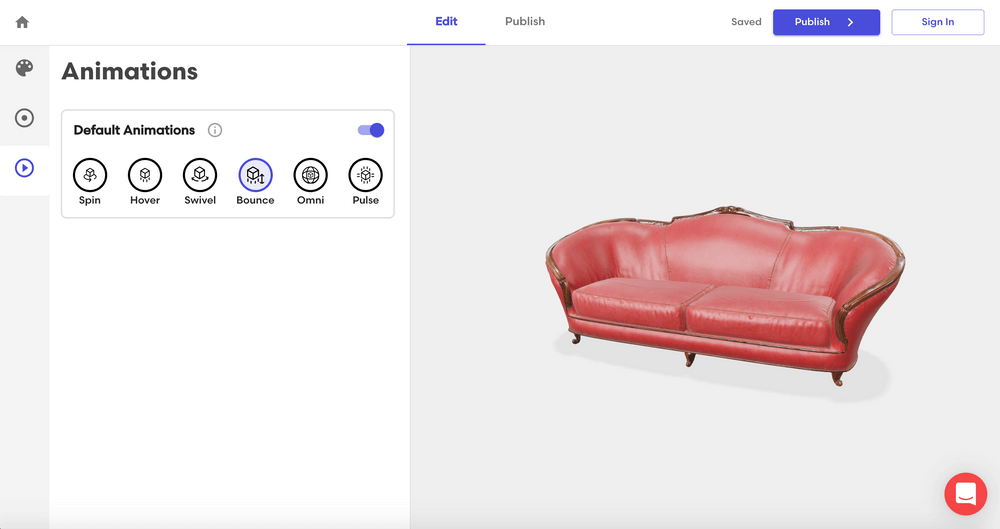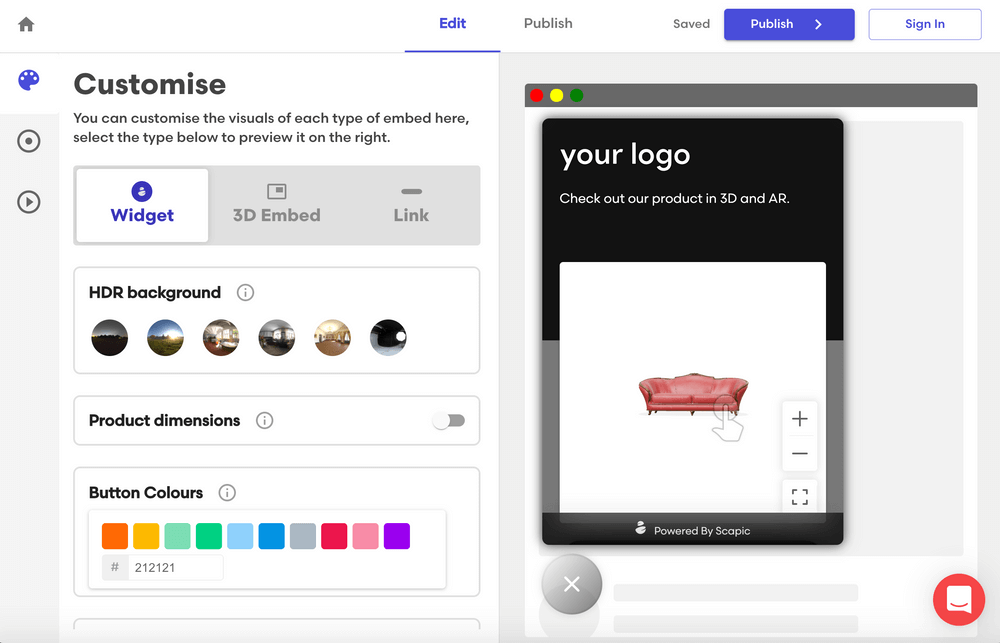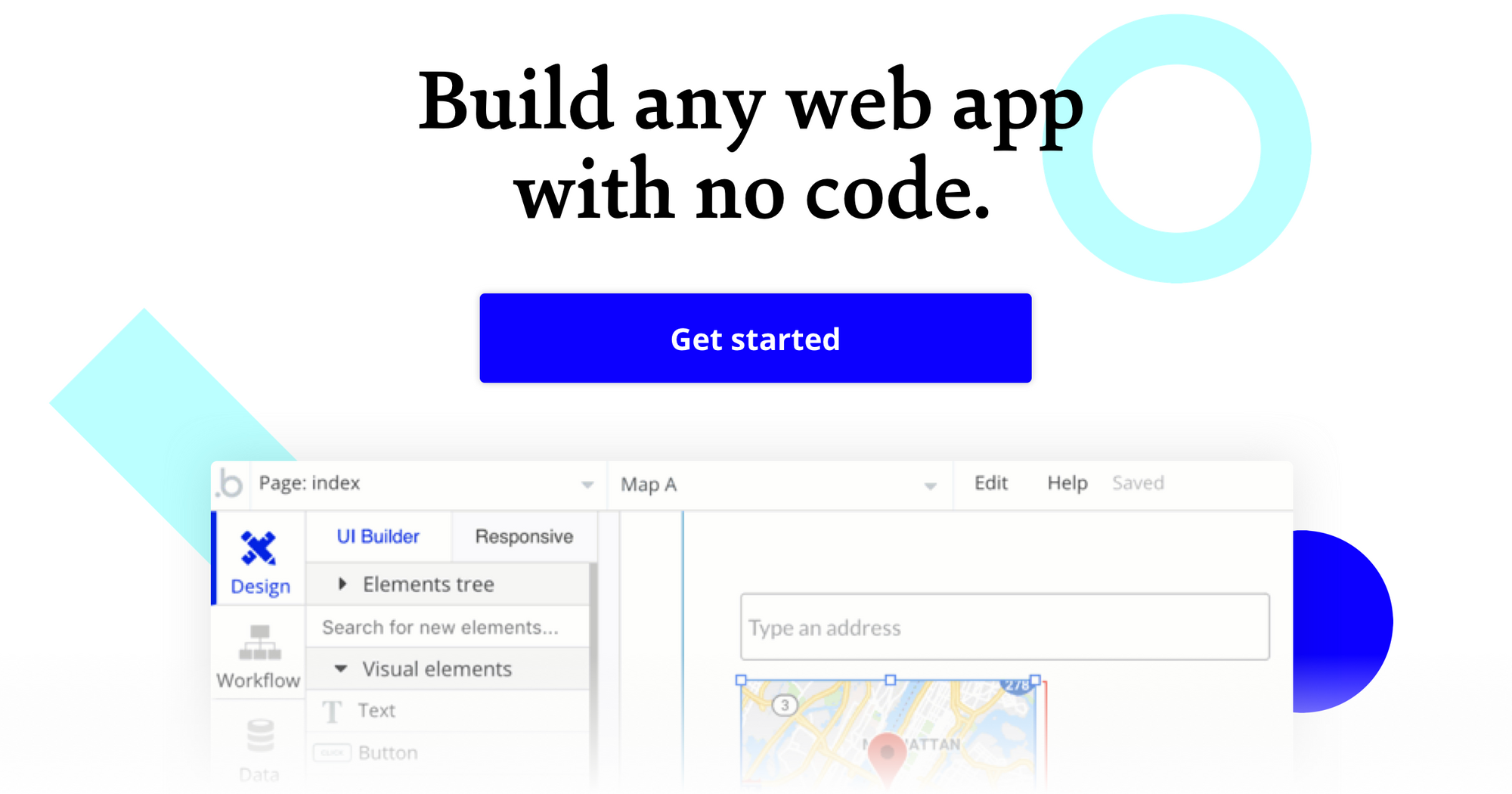At Bubble, we want to enable potential builders to create their ideas without code, so we are exploring and reviewing the many tools and software that enterprises might use to build apps.
What is Scapic?
A B2B service, Scapic allows you to integrate 3D images and augmented reality (AR) into e-commerce websites that are built on platforms like Shopify and WooCommerce.

With Scapic, you receive access to a no-code dashboard that lets you enable VR/AR, generate 360° views of your products, and create 3D experiences, all within your browser. Using the drag-and-drop editor, you can create high-fidelity visualizations of your product by adjusting the shape and size of your images.
If you want to draw attention to a certain project, you are equipped with tools for building landing pages with custom activation messages, embing 3D models into your site, developing experiential demos, or creating virtual shopping experiences that mimic walking through an actual store. According to Scapic, the realistic AR experience can, on average, increase customer engagement, as measured by click through rates and user dwell time.
Who is Scapic for?
A SaaS product, Scapic can benefit companies that are currently using Shopify, WooCommerce, Magento, and BigCommerce. Customers include retailers such as Royal Enfield, apartment18, Green Soul Ergonomics, Myntra, and Bent Chair.
B2B marketing managers who are looking to increase conversions and reduce product return rates, or who want to create 3D experiences without writing code, will find Scapic useful for enhancing their product images.
Aside from companies in the e-commerce and retail sectors, organizations that are planning to host virtual conferences or arrange virtual tours can benefit from using Scapic.
Scapic Cost and Pricing?
(Pricing model evaluation: June 2020)
Scapic pricing is based on the number of impressions per month. All plans come with AR tools, editor support, and an unlimited number of SKUs (stock keeping units)/products. To get an official price quote, you must schedule a demo with the Scapic team. If you’re not sure which option is the best fit for your business, you should pick your plan based on how much traffic you currently have or expect to have on your app.
Starter (The Growth Plan): The Scapic Starter plan comes with up to 10,000 impressions per month. Users with 100-10k views/month on their app should choose this.
Essentials (The Essentials): Besides including up to 50,000 impressions/month, Scapic’s Essentials plan comes with custom branding, custom call to action messages, and advanced analytics tools. This tier is ideal for apps with 10k-60k views per month.
Plus (The Comprehensive Plan): Scopic’s Plus option comes with the same benefits offered by the Essentials plan, as well email reports of analytics & up to 150k impressions each month, for apps with 60k-200k views/month.
Advanced (The Enterprise Plan): The most expensive option, Scopic’s Advanced plan is for larger businesses and enterprises and includes customized impressions features for apps with more than 200k views a month.
Scapic vs. Bubble: A Comparison
How does the AR e-commerce model of Scapic compare to a more comprehensive no-code platform like Bubble?
Similarities between Scapic and Bubble:
Both Scapic and Bubble are no-code tools.
Both can help enhance your e-commerce business.
Both Scapic and Bubble provide drag-and-drop editors.
Both equip you with the tools to create striking animations and visualizations.
The key differences between Scapic and Bubble are:
Enterprises vs. Entrepreneurs: Scapic users include organizations in the retail, e-commerce, and tourism sectors. With Bubble, enterprises and smaller businesses can create prototypes or quickly generate MVPs; many end up building their companies using Bubble exclusively. Bubble users come from a wide range of industries and backgrounds; they are freelancers, solo entrepreneurs, hobbyists, artists, developers, educators, and students.
Pricing: Bubble’s starting plan is free to use; production pricing for companies building on Bubble can be either $115 or $475 a month, with all features included and no minimum contract. Enterprise clients of Bubble can also request a dedicated plan cluster with robust technical support. Scapic does not offer a free plan; to get a quote from Scapic, you must schedule a demo with their team.
B2B vs. B2C: Scapic is a B2B software, and their product helps established retailers and e-commerce businesses enhance product visualizations with the help of AR/VR. Bubble users can create B2B SaaS products, as well B2C platforms for end users, like complex marketplaces and social networks.
E-Commerce Capabilities: With Bubble, you are equipped with the necessary tools to build complex marketplaces from scratch or from templates. Building features such as a product page, coupon code fields, a shopping cart, web receipts, and admin dashboards are possible using Bubble alone. To customize your e-commerce site, Bubble offers 1000+ plugins, including payment gateways such as PayPal, Stripe, Amazon Pay, and Coinbase (cryptocurrency).

Scapic, on the other hand, is designed to enhance pre-existing e-commerce sites; the no-code tool provides an augmented reality (AR) shopping experience that aims to increase conversion rates.
Alternatives to Scapic
Alternative no-code CMS platforms or tools that allow you to build a web applications without code include the following tools:
If you’re looking for a platform that has support for native or mobile apps, consider using no-code tools like Adalo, Glide, or Thunkable.
If you have an online business that sells things like music, comics, software, and books, and you would prefer to use a platform with pre-built components, take a look at Gumroad.
If you’re launching an e-commerce website and need basic landing pages and simple CMS, or would rather use a website template, consider templated website hosts like Carrd, Squarespace, Wix, or Weebly as alternatives.
If your needs fall outside the scope of traditional CMS (like building a full marketplace) and you require full backend database functionality built-in, no-code platforms like Bubble are a good alternative to Scapic.
If you want an open-source CMS platform with e-commerce plugins, try WordPress
About Bubble
Bubble is a leader in the no-code movement. Bubble offers a powerful point-and-click web editor and cloud hosting platform that allows users to build fully customizable web applications and workflows, ranging from simple prototypes to complex marketplaces, SaaS products, and more. Over 400,000 users are currently building and launching businesses on Bubble - some have gone on to participate in top accelerator programs, such as Y Combinator, and even raised $365M in venture funding. Bubble is more than just a product. We are a strong community of builders and entrepreneurs that are united by the belief that everyone should be able to create technology.
Join the no-code movement today.
Disclaimer: The goal of these reviews is to provide an honest, practical, differentiated comparison of features and educate readers on tools in the no-code ecosystem so that you can evaluate how these services fit together and serve your needs.
Build for as long as you want on the Free plan. Only upgrade when you're ready to launch.
Join Bubble







